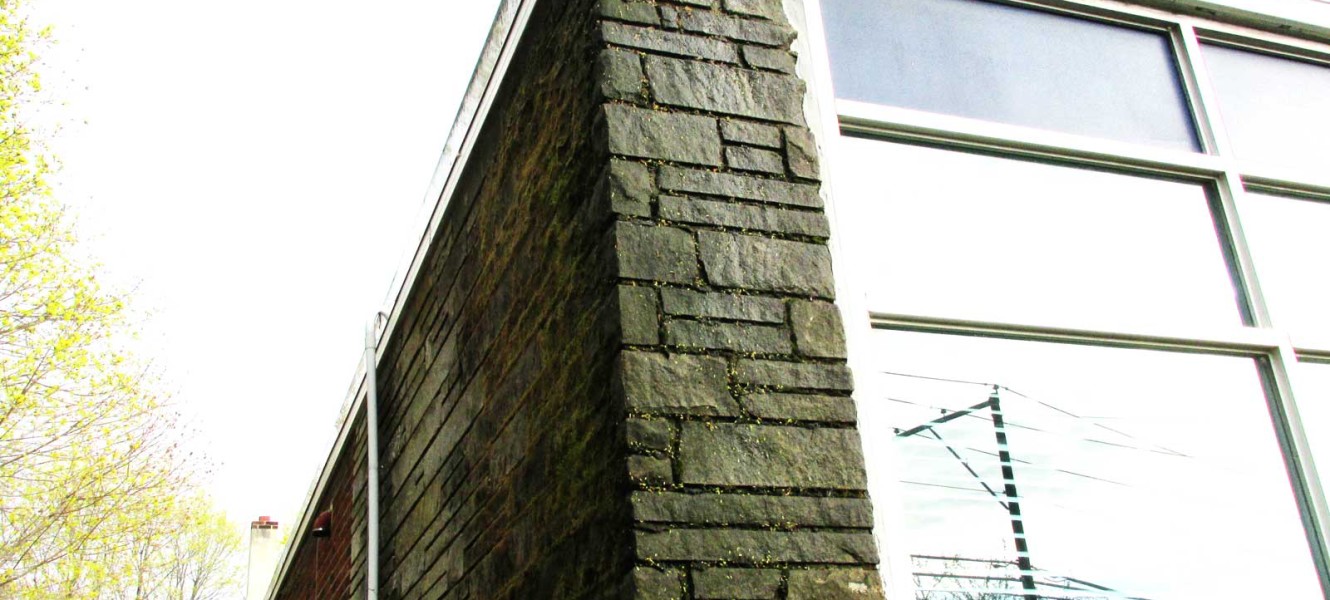 Hazardous materials investigation that included water damage on the exterior corner of the building from water runoff over the lip of the roof.
Hazardous materials investigation that included water damage on the exterior corner of the building from water runoff over the lip of the roof.Water Damage and Hazardous Materials Identified in Orwigsburg
Muhlenberg Greene Architects
Water damage can easily plague any home or business after a flooding event or small leak from the roof or plumbing fixture. The damp conditions associated with any residual moisture in porous materials can become the perfect habitat for mold growth. The Orwigsburg Post Office experienced the moldy after effects of water damage first hand. Element Environmental Solutions (E2S) was brought in to perform a hazardous materials investigation to determine the presence of asbestos containing material, lead-based paint (LBP), and suspected mold growth.
The hazardous materials investigation included asbestos-containing material identification, lead-based paint (LBP) inspection, and visual inspection and sampling of suspected mold growth (surface and airborne spores). The investigation revealed that the post office did not contain any lead-based paint; however, asbestos and mold growth were prevalent within the building. E2S identified asbestos-containing material inside and outside of the building. Exterior window caulking and 9” x 9” floor tiles located in the main room of the post office both contained asbestos above regulated levels (>1%). E2S recommended the ACM be removed by professionals before any renovations take place. In the appropriate removal of disturbing ACM can lead to the release of asbestos fibers into the air, which can result in respiratory irritation along with multiple long-term side effects such as asbestosis and lung cancers.
The hazardous materials investigation also revealed the danger of untreated water damage issues. E2S identified extensive mold contamination in the Postmaster’s Office. Mold thrives in a moist environment with poor air circulation and can contaminate an area from the inside out, or in this case from the outside-in. Not from a leaky roof, but from water runoff over the lip of the roof which maintained very wet conditions onto the exterior wall and then soaking into the porous mortar. The wet conditions allowed extensive moss growth on the exterior stone and mortar. This heavy moss growth retained the moisture, keeping the exterior wall wet longer allowing more water penetration into the structure.
The analytical results indicated that there were multiple genera of mold, the most notable being, Cladosporium, Aspergillus/Penicillium, and Stachybotrys:
- Cladosporium and Aspergillus/Penicillium are both very common types of mold that occur indoors from water damage. Both types of mold can cause symptoms to those who have asthma or allergies and are allergic to those molds.
- Stachybotrys, or black mold, also commonly occurs indoors. The Center for Disease Control has identified Stachybotrys as potentially hazardous to humans. The most common medical ailment associated with this type of mold is upper respiratory tract problems, as well as other respiratory issues like asthma.
The extensive mold growth at the Orwsigburg Post Office was associated with water intrusion, but the exact source of the water damage was not apparent at first. Investigation of the exterior of the building revealed large puddles of water collecting on the roof of the building. This was believed to be the source of the water damage, perhaps a leaking roof. A more careful investigation by the E2S professionals on site led to the discovery of mortar that was wet for extended periods of time, located on the southern exterior of the building. The water was migrating through the porous mortar and into the building where moisture saturated the interior walls and on the carpet producing the abundance of mold growth. E2S professionals recommended the professional removal of all water damaged and mold effected materials before renovations could be completed. In addition, improvements to roof drainage to eliminate the moss on the exterior wall were suggested.
The Orwigsburg Post Office demonstrated complications that can be associated with untreated water damage from a source that is not readily apparent. Mold growth can be potentially dangerous when it occurs within an occupied space and should always be addressed in a timely manner to decrease the risk of adverse health effects. Mold growth is not always so obvious especially when it occurs behind drywall. If you suspect mold growth may be an in issue at your facility, contact E2S to investigate and develop the best solution to mitigate any indoor air quality concerns.


